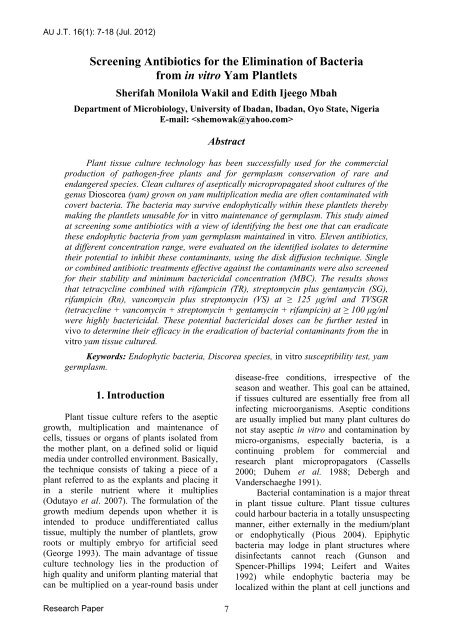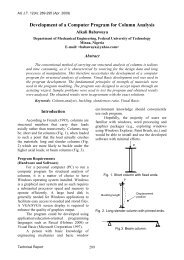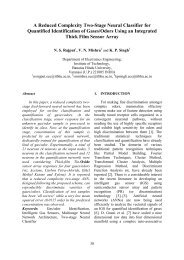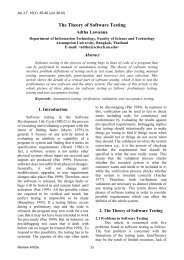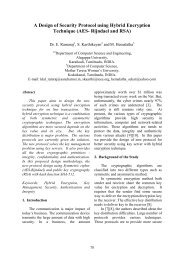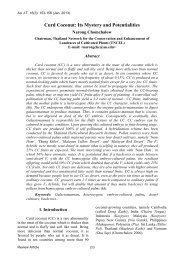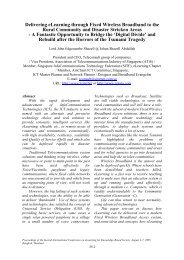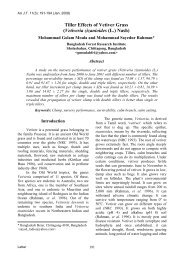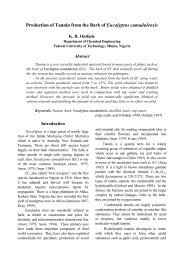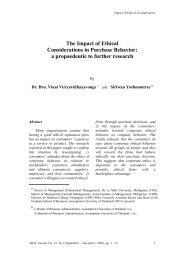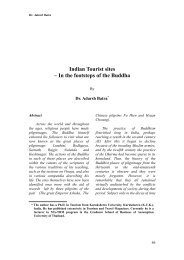Screening Antibiotics for the Elimination of Bacteria ... - AU Journal
Screening Antibiotics for the Elimination of Bacteria ... - AU Journal
Screening Antibiotics for the Elimination of Bacteria ... - AU Journal
You also want an ePaper? Increase the reach of your titles
YUMPU automatically turns print PDFs into web optimized ePapers that Google loves.
<strong>AU</strong> J.T. 16(1): 7-18 (Jul. 2012)<br />
<strong>Screening</strong> <strong>Antibiotics</strong> <strong>for</strong> <strong>the</strong> <strong>Elimination</strong> <strong>of</strong> <strong>Bacteria</strong><br />
from in vitro Yam Plantlets<br />
Sherifah Monilola Wakil and Edith Ijeego Mbah<br />
Department <strong>of</strong> Microbiology, University <strong>of</strong> Ibadan, Ibadan, Oyo State, Nigeria<br />
E-mail: <br />
Abstract<br />
Plant tissue culture technology has been successfully used <strong>for</strong> <strong>the</strong> commercial<br />
production <strong>of</strong> pathogen-free plants and <strong>for</strong> germplasm conservation <strong>of</strong> rare and<br />
endangered species. Clean cultures <strong>of</strong> aseptically micropropagated shoot cultures <strong>of</strong> <strong>the</strong><br />
genus Dioscorea (yam) grown on yam multiplication media are <strong>of</strong>ten contaminated with<br />
covert bacteria. The bacteria may survive endophytically within <strong>the</strong>se plantlets <strong>the</strong>reby<br />
making <strong>the</strong> plantlets unusable <strong>for</strong> in vitro maintenance <strong>of</strong> germplasm. This study aimed<br />
at screening some antibiotics with a view <strong>of</strong> identifying <strong>the</strong> best one that can eradicate<br />
<strong>the</strong>se endophytic bacteria from yam germplasm maintained in vitro. Eleven antibiotics,<br />
at different concentration range, were evaluated on <strong>the</strong> identified isolates to determine<br />
<strong>the</strong>ir potential to inhibit <strong>the</strong>se contaminants, using <strong>the</strong> disk diffusion technique. Single<br />
or combined antibiotic treatments effective against <strong>the</strong> contaminants were also screened<br />
<strong>for</strong> <strong>the</strong>ir stability and minimum bactericidal concentration (MBC). The results shows<br />
that tetracycline combined with rifampicin (TR), streptomycin plus gentamycin (SG),<br />
rifampicin (Rn), vancomycin plus streptomycin (VS) at ≥ 125 μg/ml and TVSGR<br />
(tetracycline + vancomycin + streptomycin + gentamycin + rifampicin) at ≥ 100 μg/ml<br />
were highly bactericidal. These potential bactericidal doses can be fur<strong>the</strong>r tested in<br />
vivo to determine <strong>the</strong>ir efficacy in <strong>the</strong> eradication <strong>of</strong> bacterial contaminants from <strong>the</strong> in<br />
vitro yam tissue cultured.<br />
Keywords: Endophytic bacteria, Discorea species, in vitro susceptibility test, yam<br />
germplasm.<br />
disease-free conditions, irrespective <strong>of</strong> <strong>the</strong><br />
season and wea<strong>the</strong>r. This goal can be attained,<br />
1. Introduction<br />
if tissues cultured are essentially free from all<br />
infecting microorganisms. Aseptic conditions<br />
Plant tissue culture refers to <strong>the</strong> aseptic are usually implied but many plant cultures do<br />
growth, multiplication and maintenance <strong>of</strong> not stay aseptic in vitro and contamination by<br />
cells, tissues or organs <strong>of</strong> plants isolated from micro-organisms, especially bacteria, is a<br />
<strong>the</strong> mo<strong>the</strong>r plant, on a defined solid or liquid continuing problem <strong>for</strong> commercial and<br />
media under controlled environment. Basically, research plant micropropagators (Cassells<br />
<strong>the</strong> technique consists <strong>of</strong> taking a piece <strong>of</strong> a 2000; Duhem et al. 1988; Debergh and<br />
plant referred to as <strong>the</strong> explants and placing it Vanderschaeghe 1991).<br />
in a sterile nutrient where it multiplies <strong>Bacteria</strong>l contamination is a major threat<br />
(Odutayo et al. 2007). The <strong>for</strong>mulation <strong>of</strong> <strong>the</strong> in plant tissue culture. Plant tissue cultures<br />
growth medium depends upon whe<strong>the</strong>r it is could harbour bacteria in a totally unsuspecting<br />
intended to produce undifferentiated callus manner, ei<strong>the</strong>r externally in <strong>the</strong> medium/plant<br />
tissue, multiply <strong>the</strong> number <strong>of</strong> plantlets, grow or endophytically (Pious 2004). Epiphytic<br />
roots or multiply embryo <strong>for</strong> artificial seed bacteria may lodge in plant structures where<br />
(George 1993). The main advantage <strong>of</strong> tissue disinfectants cannot reach (Gunson and<br />
culture technology lies in <strong>the</strong> production <strong>of</strong> Spencer-Phillips 1994; Leifert and Waites<br />
high quality and uni<strong>for</strong>m planting material that 1992) while endophytic bacteria may be<br />
can be multiplied on a year-round basis under localized within <strong>the</strong> plant at cell junctions and<br />
Research Paper 7
<strong>AU</strong> J.T. 16(1): 7-18 (Jul. 2012)<br />
<strong>the</strong> intercellular spaces <strong>of</strong> cortical parenchyma<br />
(Gunson and Spencer-Phillips 1994).<br />
According to Reed et al. (1995), bacterial<br />
contaminants found at explants initiation,<br />
present in explants from collection dates and<br />
resistant to surface disinfection are likely to be<br />
endophytic. Both surface sterilization-resistant<br />
micro-organisms and endophytic microorganisms<br />
(Cassells 2001) may survive in <strong>the</strong><br />
plant material <strong>for</strong> several subculture cycles and<br />
over extended periods <strong>of</strong> time without<br />
expressing symptoms in <strong>the</strong> tissue or visible<br />
signs in <strong>the</strong> medium (Van den Houwe and<br />
Swennen 2000). Presence <strong>of</strong> <strong>the</strong>se bacteria in<br />
<strong>the</strong> cultures is highly undesirable due to<br />
adverse effects on growth (Leifert and Waites<br />
1992; Thomas 2004), lack <strong>of</strong> reproducibility <strong>of</strong><br />
tissue-culture protocols (Thomas 2004)<br />
ramifications in cell cultures (Horsch and King<br />
1983), possibility <strong>of</strong> carrying pathogens<br />
(Cooke et al. 1992), potential risk to in vitro<br />
gene banks (Van den Houwe and Swennen<br />
2000) and a barrier <strong>for</strong> safe exchange <strong>of</strong><br />
germplasm (Salih et al. 2001). These factors<br />
reduce <strong>the</strong> potential reliability <strong>of</strong> plant<br />
cell/tissue-culture systems (Cassells 2001;<br />
Thomas 2004).<br />
The major challenges that yam<br />
production is facing using tissue culture<br />
techniques are that <strong>of</strong> endophytic bacterial<br />
contamination. Burkholderia spp., Luteibacter<br />
rhizovicinus and Bacillus cereus are <strong>the</strong> major<br />
bacteria contaminants implicated in <strong>the</strong> Yam<br />
Tissue Culture at <strong>the</strong> Institute <strong>of</strong> Tropical<br />
Agriculture Ibadan (IITA), Nigeria. These<br />
bacteria have been found to be plant-associated<br />
bacteria (Kotiranta et al. 2000; Coenye and<br />
Vandamme 2003; Johansen et al. 2005;<br />
Janssen 2006; and Compant et al. 2008) which<br />
infect cultures when explants materials from<br />
<strong>the</strong> field are not properly disinfected/<br />
decontaminated. In addition, Bacillus cereus<br />
has also been reported as opportunistic human<br />
pathogen (H<strong>of</strong>fmaster et al. 2006) which is<br />
always derived from <strong>the</strong> plant propagator.<br />
Several antibiotics are frequently used in<br />
plant biotechnology to eliminate endogenous<br />
bacteria in plant tissue culture although<br />
aaccording to Cornu and Michel (1987),<br />
knowledge <strong>of</strong> <strong>the</strong> effect <strong>of</strong> antibiotics, on both<br />
bacteria and plants is important <strong>for</strong> <strong>the</strong><br />
elimination <strong>of</strong> contaminants and <strong>the</strong> recovery<br />
<strong>of</strong> healthy plants. Bonev et al. (2008) reported<br />
that <strong>the</strong> efficacy <strong>of</strong> antibiotics can be assessed<br />
by <strong>the</strong>ir ability to suppress bacterial growth,<br />
described by <strong>the</strong> MIC, or by <strong>the</strong>ir ability to kill<br />
bacteria, characterized by <strong>the</strong> minimal<br />
bactericidal concentration (MBC). Hence,<br />
antibiotic screening remains <strong>the</strong> primary<br />
requisite <strong>for</strong> tackling <strong>the</strong> covert contamination<br />
problem. There<strong>for</strong>e, <strong>the</strong> objectives <strong>of</strong> this<br />
research was to screen a selected range <strong>of</strong><br />
antibiotics against <strong>the</strong> three identified yam<br />
tissue culture bacterial contaminants<br />
(Burkholderia spp., Luteibacter rhizovicinus<br />
and Bacillus cereus) and to determine <strong>the</strong><br />
bactericidal activities <strong>of</strong> <strong>the</strong> most effective<br />
antibiotics.<br />
2. Materials and Methods<br />
2.1 Test Organisms<br />
Three bacterial isolates obtained from<br />
contaminated in vitro yam plantlets by <strong>the</strong><br />
pathology team and identified as Burkholderia<br />
spp. (IMI No 395525), Luteibacter rhizovicinus<br />
(IMI No 395527), and Bacillus cereus (IMI No<br />
395528) by <strong>the</strong> Commonwealth Agricultural<br />
Bureaux (CABI) were used <strong>for</strong> <strong>the</strong> study. All<br />
isolates were cultivated by streaking onto<br />
Muller-Hinton agar medium (MHA) and<br />
incubating at 35-37 o C <strong>for</strong> 18-24 hours.<br />
2.2 Antimicrobial Agents<br />
A total <strong>of</strong> eleven antibiotics, obtained<br />
from Sigma-Aldrich, Corporation (Poole, UK),<br />
were used <strong>for</strong> <strong>the</strong> preliminary screening<br />
(ampicillin, penicillin G, tetracycline,<br />
vancomycin, streptomycin, rifampicin,<br />
gentamycin, bacitracin, cefotaxime,<br />
trimethoprim and carbenicillin). All stock<br />
solutions were prepared from reagent-grade<br />
powders to produce 1-mg/ml solutions by using<br />
<strong>the</strong> solvents and diluents suggested in Clinical<br />
Laboratory Standards Institute document<br />
M100-S17 (NCCLS 2001). Stock solutions<br />
were filter-sterilized (pore 0.22 µm, millipore),<br />
stored at -20 o C, and used within <strong>the</strong><br />
recommended period.<br />
Research Paper 8
<strong>AU</strong> J.T. 16(1): 7-18 (Jul. 2012)<br />
Antibiotic paper discs <strong>of</strong> different known<br />
concentrations were prepared by soaking sterile<br />
paper discs with appropriate antibiotic<br />
concentrations derived from a two-fold dilution<br />
<strong>of</strong> <strong>the</strong> stock solutions. The method employed<br />
<strong>for</strong> impregnating antibiotics to discs was <strong>the</strong><br />
immersion method. It was assumed by <strong>the</strong><br />
World Health Organization (WHO) and<br />
NCCLS that a paper disc could absorb 0.02 ml<br />
<strong>of</strong> <strong>the</strong> solutions (NCCLS 1984). The wet<br />
inoculated antibiotic paper discs plate were<br />
sealed with Para films and dried inside an<br />
incubator at 35-37 o C.<br />
2.3 Antibiotic Susceptibility Testing<br />
Prior to <strong>the</strong> antibiotic susceptibility test,<br />
each <strong>of</strong> <strong>the</strong> three isolates (Burkholderia spp.,<br />
Luteibacter rhizovicinus and Bacillus cereus)<br />
grown on a Muller-Hinton agar plate <strong>for</strong> 18-24<br />
hours at 35-37 o C was standardized. <strong>Bacteria</strong>l<br />
standardization was done by suspending well<br />
isolated colonies <strong>of</strong> <strong>the</strong> same morphology in a<br />
test tube containing sterile normal saline and<br />
mixed until it attained <strong>the</strong> turbidity <strong>of</strong> 0.5<br />
McFarland standard (i.e. each suspension<br />
containing 1-2×10 8 cfu /ml <strong>of</strong> bacteria).<br />
The antibiotic minimum inhibitory<br />
concentration (MIC) was determined according<br />
to <strong>the</strong> procedures detailed by <strong>the</strong> NCCLS<br />
(NCCLS 2001). The antibiotic susceptibility<br />
testing <strong>of</strong> <strong>the</strong> three isolates (i.e. Burkholderia<br />
spp., Luteibacter rhizovicinus and Bacillus<br />
cereus) was carried out using a final antibiotic<br />
concentrations ranging from 3.9-1,000 mg/L<br />
following <strong>the</strong> procedure <strong>of</strong> <strong>the</strong> disc diffusion<br />
method (Saeed et al. 2007). In this method,<br />
sterile cotton swabs dipped into appropriate<br />
adjusted bacterial suspensions <strong>of</strong> 0.1 optical<br />
densities, squeezed against <strong>the</strong> side <strong>of</strong> <strong>the</strong><br />
suspension tubes to remove excess fluid were<br />
streaked across <strong>the</strong> sterile Mueller-Hinton agar<br />
plates. The streaking was done thrice <strong>for</strong> each<br />
plate, with <strong>the</strong> plate rotated approximately 60 o<br />
between each streaking. After approximately<br />
10 to 15 min, to allow absorption <strong>of</strong> excess<br />
moisture into <strong>the</strong> agar, three antimicrobial discs<br />
<strong>of</strong> <strong>the</strong> same concentrations were placed<br />
aseptically and at opposing directions on each<br />
plate. In <strong>the</strong> control plates, sterile disc<br />
containing no antibiotics were inoculated on<br />
seeded plates. All samples were tested in<br />
triplicates. The inoculated plates were sealed<br />
and incubated at 35-37 o C <strong>for</strong> 18-24 hours in an<br />
inverted position. The diameters <strong>of</strong> <strong>the</strong><br />
inhibition zones around <strong>the</strong> discs were<br />
measured and recorded. MIC was defined as<br />
<strong>the</strong> lowest concentration <strong>of</strong> antibiotic to inhibit<br />
bacterial growth.<br />
Five antibiotics (gentamycin,<br />
vancomycin, tetracycline, rifampicin and<br />
streptomycin) selected based on <strong>the</strong>ir<br />
effectiveness in <strong>the</strong> susceptibility test<br />
conducted were combined toge<strong>the</strong>r as TVSGR<br />
(tetracycline + vancomycin + streptomycin +<br />
gentamycin + rifampicin) and also in <strong>the</strong><br />
combinations <strong>of</strong> two <strong>for</strong>ming ten antibiotic<br />
combination treatments: tetracycline +<br />
vancomycin (TV), tetracycline + streptomycin<br />
(TS), tetracycline + gentamycin (TG),<br />
vancomycin + streptomycin (VS), vancomycin<br />
+ gentamycin (VG), vancomycin + rifampicin<br />
(VR), streptomycin + gentamycin (SG),<br />
streptomycin + rifampicin (SR) and<br />
gentamycin + rifampicin (GR). All <strong>the</strong><br />
antibiotics combination treatments at a<br />
concentration range <strong>of</strong> 15.6-250 µg/ml <strong>for</strong> <strong>the</strong><br />
two-combination treatments and 3-200 µg/ml<br />
<strong>for</strong> <strong>the</strong> five-combination treatments were also<br />
subjected to a preliminary screening following<br />
<strong>the</strong> procedures detailed in <strong>the</strong> single antibiotic<br />
treatment. The MIC’s were recorded after 18-<br />
24 hours <strong>of</strong> incubation. <strong>Antibiotics</strong> screening<br />
<strong>for</strong> all <strong>the</strong> obtained records (i.e. from <strong>the</strong> single,<br />
combination <strong>of</strong> two and five antibiotic<br />
treatments) at <strong>the</strong>ir different concentration<br />
levels on <strong>the</strong> three isolates were repeated once<br />
and each isolate treatment was replicated three<br />
times in a single run.<br />
2.4 Antibiotic Stability Determination<br />
The clear zones <strong>of</strong> inhibition in <strong>the</strong><br />
various inoculated plates were monitored in <strong>the</strong><br />
incubator <strong>for</strong> a period <strong>of</strong> 5 days to check <strong>for</strong> <strong>the</strong><br />
stability <strong>of</strong> <strong>the</strong> antibiotic treatments. Plates<br />
showing absence <strong>of</strong> resistant colonies on <strong>the</strong><br />
clear zones <strong>of</strong> inhibition were considered stable<br />
and used <strong>for</strong> <strong>the</strong> minimum bactericidal concentration<br />
(MBC) determination while presence <strong>of</strong><br />
mutants proved <strong>the</strong> antibiotics unstable and<br />
were not used <strong>for</strong> <strong>the</strong> MBC determination.<br />
Research Paper 9
<strong>AU</strong> J.T. 16(1): 7-18 (Jul. 2012)<br />
2.5 Minimum Bactericidal Concentration<br />
Determination (MBC)<br />
The various antibiotic concentrations<br />
selected from <strong>the</strong> antibiotic stability<br />
determination were used <strong>for</strong> this experiment.<br />
MBC determination was effectively done,<br />
using <strong>the</strong> broth dilution method. Antibioticcontaining<br />
broth <strong>of</strong> appropriate concentrations<br />
was inoculated with 1 ml <strong>of</strong> <strong>the</strong> corresponding<br />
bacterial suspensions and incubated <strong>for</strong> 18-24<br />
hours at 35-37 o C. Antibiotic-free broth<br />
inoculated with 1 ml <strong>of</strong> bacterial suspension<br />
served as a control <strong>for</strong> each <strong>of</strong> <strong>the</strong> isolates.<br />
After incubation, turbid broth in tubes<br />
indicated visible growth <strong>of</strong> microorganisms<br />
while non turbid broth showed no visible<br />
growth. The quantity, 0.1 ml <strong>of</strong> <strong>the</strong> non-turbid<br />
broth were inoculated onto a sterile Mueller-<br />
Hinton agar medium using a pour plate method<br />
and incubated <strong>for</strong> 18-24 hours to ascertain <strong>the</strong><br />
bactericidal effectiveness <strong>of</strong> <strong>the</strong> antibiotics.<br />
2.6 Statistical Analysis<br />
The final data are reported as <strong>the</strong> mean <strong>of</strong><br />
three replications <strong>for</strong> each antibiotic treatment.<br />
Statistical analysis <strong>of</strong> <strong>the</strong> data recorded from<br />
<strong>the</strong> experiment was per<strong>for</strong>med using <strong>the</strong><br />
analysis <strong>of</strong> variance (ANOVA) and P < 0·0001<br />
value was taken to indicate significance. All<br />
analyses were per<strong>for</strong>med in SAS (version 9.1,<br />
SAS Institute (2003), Cary, NC, USA) using<br />
<strong>the</strong> PROC GLM procedure.<br />
3. Results<br />
3.1 Evaluation <strong>of</strong> <strong>Antibiotics</strong> <strong>Screening</strong> on<br />
<strong>the</strong> <strong>Bacteria</strong>l Isolates<br />
Susceptibility test results <strong>for</strong> <strong>the</strong><br />
antibiotics were obtained from <strong>the</strong> data<br />
generated by <strong>the</strong> disc diffusion method. The<br />
disc diffusion method <strong>for</strong> antibacterial activity<br />
showed significant reduction in bacterial<br />
growth in terms <strong>of</strong> zones <strong>of</strong> inhibition around<br />
<strong>the</strong> discs. The mean <strong>of</strong> <strong>the</strong> growth inhibition<br />
zones <strong>of</strong> each <strong>of</strong> <strong>the</strong> bacteria at <strong>the</strong>ir different<br />
antibiotics (single and in combinations <strong>of</strong> two<br />
and five) concentration levels are shown in<br />
Tables 1 and 3. Results <strong>of</strong> <strong>the</strong> activities <strong>of</strong> <strong>the</strong><br />
single, combinations <strong>of</strong> two and five-antibiotics<br />
on each <strong>of</strong> <strong>the</strong> bacteria revealed that <strong>the</strong> zones<br />
<strong>of</strong> inhibition increased with increase in <strong>the</strong><br />
antibiotic concentrations, thus, exhibiting<br />
concentration dependent activity.<br />
3.2 Single <strong>Antibiotics</strong> Treatments<br />
The antibacterial activities and <strong>the</strong>ir<br />
corresponding MIC <strong>of</strong> <strong>the</strong> 11 selected<br />
antibiotics screened against Burkholderia spp.,<br />
Luteibacter rhizovicinus and Bacillus cereus<br />
are shown in Table 1. The antibiotic sensitivity<br />
tests revealed that all isolates were more<br />
sensitive to tetracycline, vancomycin,<br />
streptomycin, gentamycin and rifampicin (i.e.<br />
wider zones <strong>of</strong> inhibition and sensitive at lower<br />
antibiotics concentration (Table 3)). Among <strong>the</strong><br />
five most efficient antibiotics (tetracycline,<br />
vancomycin, streptomycin, gentamycin and<br />
rifampicin), gentamycin showed <strong>the</strong> largest<br />
zones <strong>of</strong> inhibition (18.5-25.2 mm) against <strong>the</strong><br />
three bacteria at higher concentrations (250-<br />
1,000 µg/ml) with no observed significant<br />
differences (P > 0.0001) between <strong>the</strong> <strong>Bacteria</strong><br />
strains. Results also showed that carbenicillin<br />
and trimetoprim showed no inhibitory effect<br />
against <strong>the</strong> three bacteria studied at all <strong>the</strong><br />
different levels <strong>of</strong> concentrations (3.0-1,000<br />
µg/ml). On <strong>the</strong> contrary, rifampicin presented<br />
growth inhibition zones at all <strong>the</strong> different<br />
concentration levels ranging from 9.7-22 mm<br />
while bacitracin, penicillin G, ampicillin and<br />
ce<strong>for</strong>taxime had poor activity with very small<br />
zones <strong>of</strong> inhibition (0-12 mm) which occurred<br />
only at <strong>the</strong> higher concentration levels (250-<br />
1,000 µg/ml). In general, <strong>the</strong> least inhibitory<br />
effect <strong>of</strong> <strong>the</strong> five effective antibiotics was<br />
found on Luteibacter rhizovicinus while<br />
Bacillus cereus and Burkholderia spp. were<br />
detected to be <strong>the</strong> most sensitive bacteria. No<br />
growth inhibition was observed in <strong>the</strong> control<br />
group.The variation in size <strong>of</strong> zones <strong>of</strong><br />
inhibition with different antibiotic<br />
concentrations was found to be statistically<br />
significant at most concentration.<br />
Research Paper 10
<strong>AU</strong> J.T. 16(1): 7-18 (Jul. 2012)<br />
Table 1. Inhibitory zones (mm) around discs containing different concentrations <strong>of</strong> various<br />
antibiotics placed on <strong>the</strong> surface <strong>of</strong> Mueller-Hinton agar (MHA) medium inoculated with <strong>the</strong><br />
standardized yam tissue culture bacterial contaminants.<br />
<strong>Bacteria</strong><br />
Burkholderia<br />
spp.<br />
Luteibacter<br />
rhizovinus<br />
Bacillus<br />
cereus<br />
<strong>Antibiotics</strong><br />
Concentration (µg/ml)<br />
3.9 7.8 15.6 31.3 63 125 250 500 1,000<br />
Rifampicin 10.2 11 12 12.7 14.2 16.3 17.8 18.7 20<br />
Sterptomycin 0 5.2 7.2 10.2 14.7 15.5 18.8 19.3 21.2<br />
Vancomycin 0 0 1.5 1.3 4.3 11.5 13 15.2 17.7<br />
Gentamycin 0 0 3 11.7 14.3 18.7 20 21.3 25.2<br />
Tetracycline 0 0 0 0 4 8.7 9 11 13<br />
Ampicillin 0 0 0 0 2 0 2 1.3 8.5<br />
Penicillin G 0 0 0 0 0 0 0 7.8 9.7<br />
Ce<strong>for</strong>taxime 0 0 0 0 0 0 0 4.8 10.8<br />
Bacitracin 0 0 0 0 0 0 0 0 4.8<br />
Trimetoprim 0 0 0 0 0 0 0 0 0<br />
Carbenicillin 0 0 0 0 0 0 0 0 0<br />
Control 0 0 0 0 0 0 0 0 0<br />
LSD 0.3 2 2.8 2.2 2.5 1.2 1.2 2.3 2.1<br />
Rifampicin 9.7 9.8 11 12 13 14.3 15.3 17 17.5<br />
Sterptomycin 0 6.5 12 11.5 16.7 17.7 19 20.2 21.7<br />
Vancomycin 0 0 2.7 4.2 8.2 13.2 13.2 16 16.7<br />
Gentamycin 0 0 3 11 14.7 17.5 18.5 22 22.8<br />
Tetracycline 0 0 0 1.7 10.2 12.7 12.7 15 17.8<br />
Ampicillin 0 0 0 0 0 0 0 5 11<br />
Penicillin G 0 0 0 0 0 0 0 2.8 6.3<br />
Ce<strong>for</strong>taxime 0 0 0 0 0 0 0 1.5 12<br />
Bacitracin 0 0 0 0 0 0 0 1.5 8<br />
Trimetoprim 0 0 0 0 0 0 0 0 0<br />
Carbenicillin 0 0 0 0 0 0 0 0 0<br />
Control 0 0 0 0 0 0 0 0 0<br />
LSD 0.4 1.8 2.3 2.2 1.7 1.2 1.2 3.1 2.3<br />
Rifampicin 10.3 11 13 13.8 15.5 17.2 16.3 21.5 22<br />
Sterptomycin 0 0 4 8.7 13 13.8 15.8 17.2 20.2<br />
Vancomycin 0 0 0 1.5 4 11.7 13 16 18.3<br />
Gentamycin 0 0 4 11.8 16.7 19.3 21.5 23.8 25<br />
Tetracycline 0 0 0 0 3.8 4.2 9.3 10.8 12.7<br />
Ampicillin 0 0 0 0 0 0 4.2 2.8 9.5<br />
Penicillin G 0 0 0 0 0 0 0 1.5 9<br />
Ce<strong>for</strong>taxime 0 0 0 0 0 0 0 0 10.5<br />
Bacitracin 0 0 0 0 0 0 0 0 5<br />
Trimetoprim 0 0 0 0 0 0 0 0 0<br />
Carbenicillin 0 0 0 0 0 0 0 0 0<br />
Control 0 0 0 0 0 0 0 0 0<br />
LSD 0.4 0.7 3 2.3 2.5 2.1 1.8 2.8 3.7<br />
3.3 Combination <strong>of</strong> Two <strong>Antibiotics</strong><br />
From <strong>the</strong> initial 11 antibiotics screened by <strong>the</strong><br />
disc diffusion assays, <strong>the</strong> 5 antibiotics that<br />
showed effectiveness were subjected to fur<strong>the</strong>r<br />
analysis and 10 combination treatments were<br />
obtained from <strong>the</strong> combination <strong>of</strong> antibiotics in<br />
two’s. Representative results <strong>of</strong> <strong>the</strong> disc<br />
diffusion assays, with varying concentrations<br />
<strong>of</strong> <strong>the</strong> combination <strong>of</strong> two antibiotics<br />
treatments are shown in Tables 2 and 4.<br />
Research Paper 11
<strong>AU</strong> J.T. 16(1): 7-18 (Jul. 2012)<br />
Table 2. Inhibitory zones (mm) around discs containing different concentrations <strong>of</strong> various<br />
antibiotics in combinations <strong>of</strong> two placed on <strong>the</strong> surface <strong>of</strong> Mueller-Hinton agar (MHA) medium<br />
inoculated with <strong>the</strong> standardized yam tissue culture bacterial contaminants.<br />
<strong>Bacteria</strong><br />
Burkholderia spp.<br />
Luteibacter<br />
rhizovicinus<br />
Bacillus cereus<br />
LSD = Least significant difference,<br />
tetracycline + vancomycin (TV),<br />
tetracycline + streptomycin (TS),<br />
tetracycline + gentamycin (TG),<br />
tetracycline + rifampicin (TR),<br />
vancomycin + streptomycin (VS),<br />
Antibiotic<br />
Concentration(µm/ml)<br />
combination 15.6 31.3 62.5 125 250<br />
SG 11 14.3 17 20 23.7<br />
TR 10 12 15 17.3 20<br />
VR 9 6.7 14.3 16.3 18<br />
SR 0 0 16 17.3 21<br />
GR 8.3 11.7 18 18 21.7<br />
VG 0 0 13.7 18.7 21.7<br />
TS 6.3 12.7 16.7 19.7 21.7<br />
TG 3.3 14 16.7 20.7 24<br />
VS 3.3 10.7 13.3 18 19.7<br />
TV 0 0 10 10 13.3<br />
Control 0 0 0 0 0<br />
LSD (p
<strong>AU</strong> J.T. 16(1): 7-18 (Jul. 2012)<br />
Table 3. MIC <strong>of</strong> different concentration <strong>of</strong><br />
various antibiotics on <strong>the</strong> bacterial<br />
contaminants.<br />
<strong>Antibiotics</strong><br />
Minimal inhibitory<br />
concentration (µg/ml)/<br />
organisms<br />
Burkholderia<br />
spp.<br />
Bacillus<br />
cereus<br />
Rifampicin 3.9 3.9 3.9<br />
Sterptomycin 7.8 7.8 15.6<br />
Vancomycin 15.6 15.6 31.3<br />
Gentamycin 15.6 15.6 15.6<br />
Tetracycline 62.5 31.3 62.5<br />
Ampicillin 250 500 500<br />
Penicillin G 500 500 1,000<br />
Ce<strong>for</strong>taxime 500 500 500<br />
Bacitracin 1,000 500 1,000<br />
Trimetoprim 0 0 0<br />
Carbenicillin 0 0 0<br />
Control 0 0 0<br />
Table 4. MIC <strong>for</strong> different concentration <strong>of</strong><br />
various antibiotics in combination <strong>of</strong> two<br />
bacterial contaminants.<br />
Minimal Inhibitory concentration<br />
(µm/ml)<br />
Luteibacter<br />
rhizovicinus<br />
<strong>Antibiotics</strong><br />
Burkholderia<br />
spp.<br />
Luteibacter<br />
rhizoviccinus<br />
Bacillus<br />
cereus<br />
SG 15.6 15.6 31.3<br />
TR 15.6 15.6 15.6<br />
GR 15.6 15.6 15.6<br />
TS 15.6 15.6 31.3<br />
VS 15.6 15.6 31.3<br />
TG 15.6 15.6 31.3<br />
VR 15.6 15.6 15.6<br />
SR 62.5 62.5 62.5<br />
VG 62.5 15.6 15.6<br />
TV 62.5 0 15.6<br />
Control 0 0 0<br />
LSD = Least significant difference,<br />
tetracycline + vancomycin (TV),<br />
tetracycline + streptomycin (TS),<br />
tetracycline + gentamycin (TG),<br />
tetracycline + rifampicin (TR),<br />
vancomycin + streptomycin (VS),<br />
vancomycin + gentamycin (VG),<br />
vancomycin + rifampicin (VR),<br />
streptomycin + gentamycin (SG),<br />
streptomycin + rifampicin (SR),<br />
gentamycin + rifampicin (GR),<br />
control = no antibiotics.<br />
For Bacillus cereus, streptomycin +<br />
gentamycin (SG) showed higher zones <strong>of</strong><br />
inhibition at a minimal inhibitory concentration<br />
(MIC) range <strong>of</strong> ≥ 62.5 µg/ml. Also, results<br />
revealed that <strong>the</strong> combination <strong>of</strong> <strong>the</strong> two<br />
antibiotics: streptomycin + rifampicin. (SR)<br />
showed no inhibitory effect against <strong>the</strong> three<br />
bacteria studied at 15.6-31.3 µg/ml<br />
concentrations.<br />
3.4 Combination <strong>of</strong> Five <strong>Antibiotics</strong><br />
Results obtained from <strong>the</strong> antibiotics<br />
combination sensitivity tests revealed that<br />
Burkholderia spp., Luteibacter rhizovicinus<br />
and Bacillus cereus were significantly sensitive<br />
to <strong>the</strong> cocktail <strong>of</strong> <strong>the</strong> 5 effective antibiotics<br />
(tetracycline + vancomycin + streptomycin +<br />
gentamycin + rifampicin, i.e. TVSGR) at <strong>the</strong>ir<br />
different concentration levels (i.e. 3-200<br />
µg/ml). For <strong>the</strong> combination <strong>of</strong> <strong>the</strong> fiveantibiotics,<br />
TVSGR at <strong>the</strong> concentration <strong>of</strong> 200<br />
µg/ml was found to present <strong>the</strong> highest mean<br />
zones <strong>of</strong> inhibition (23-24 mm) while <strong>the</strong> 3<br />
µg/ml presented <strong>the</strong> lowest mean zones <strong>of</strong><br />
inhibition (5-6 mm) on <strong>the</strong> three isolates.<br />
Significant differences (P < 0.0001) were<br />
observed in <strong>the</strong> susceptibility <strong>of</strong> Luteibacter<br />
rhizovicinus to <strong>the</strong> various TVSGR<br />
concentration levels (i.e. 3-200 µg/ml) while<br />
<strong>for</strong> Burkholderia spp. and Bacillus cereus,<br />
<strong>the</strong>re was no significant difference (P ><br />
0.0001) observed in <strong>the</strong> activity <strong>of</strong> <strong>the</strong> TVSGR<br />
concentration at 100-200 µg/ml and 12-25<br />
µg/ml, respectively.<br />
3.5 Evaluation <strong>of</strong> <strong>the</strong> Antibiotic Stability<br />
Resistant colonies were observed in <strong>the</strong><br />
zones <strong>of</strong> inhibition <strong>of</strong> most <strong>of</strong> <strong>the</strong> single and<br />
antibiotic combination treatments derived from<br />
<strong>the</strong> antibiotic susceptibility tests. Antibiotic<br />
stability was achieved more on <strong>the</strong> antibiotic<br />
combination treatments than on <strong>the</strong> single<br />
treatments as observed after 5 days <strong>of</strong><br />
monitoring <strong>the</strong> clear zones <strong>of</strong> inhibition on <strong>the</strong><br />
isolates (Table 5). The results also shows that<br />
<strong>for</strong> both assays (single antibiotics and antibiotic<br />
combinations), clear zones <strong>of</strong> inhibition in <strong>the</strong><br />
inoculated plates assessed 5 days after <strong>the</strong><br />
antibiotic susceptibility tests revealed that two<br />
Research Paper 13
<strong>AU</strong> J.T. 16(1): 7-18 (Jul. 2012)<br />
antibiotics (rifampicin and streptomycin) out <strong>of</strong><br />
<strong>the</strong> 11 single antibiotic treatments were stable<br />
while in <strong>the</strong> combination <strong>of</strong> two-antibiotics, 3<br />
out <strong>of</strong> 10 antibiotic combination treatments:<br />
vancomycin + streptomycin (VS),<br />
tetracycline + rifampicin (TR), and<br />
streptomycin + gentamycin (SG),<br />
showed stability. The combination <strong>of</strong> fiveantibiotics<br />
(TVSGR) was also observed to be<br />
stable after 5 days. When antibiotic stability<br />
was assessed beyond five days in <strong>the</strong> incubator<br />
at 35-37 o C after <strong>the</strong> antibiotic susceptibility<br />
tests, <strong>the</strong> MHA medium at which <strong>the</strong><br />
standardized inoculums were seeded on <strong>the</strong><br />
sterile plates became exhausted (dried up).<br />
Isolates exhibited marked similarities in <strong>the</strong>ir<br />
response to antibiotics stability at <strong>the</strong>ir various<br />
concentration levels. For all unstable<br />
antibiotics on <strong>the</strong> isolates, resistant colonies<br />
(mutants) were observed on <strong>the</strong> clear zones <strong>of</strong><br />
inhibition.<br />
3.6 Evaluation <strong>of</strong> <strong>the</strong> minimal bactericidal<br />
concentrations (MBCs)<br />
All stable antibiotics against <strong>the</strong><br />
contaminating bacteria were evaluated at <strong>the</strong>ir<br />
variable concentrations by <strong>the</strong> broth dilution<br />
method to determine <strong>the</strong>ir bactericidal doses<br />
(Table 6). From <strong>the</strong> minimal bactericidal<br />
concentrations analysis conducted on <strong>the</strong> 6<br />
stable antibiotics:<br />
rifampicin (Rn),<br />
streptomycin (S),<br />
vancomycin + streptomycin (VS),<br />
streptomycin + gentamycin (SG),<br />
tetracycline + rifampicin (TR), and<br />
tetracycline + vancomycin + streptomycin +<br />
gentamycin + rifampicin (i.e. TVSGR),<br />
5 antibiotics (Rn, VS, SG, TR and TVSGR) out<br />
<strong>of</strong> <strong>the</strong> 6 had bactericidal effects on <strong>the</strong> three<br />
contaminating bacteria (Table 6). The data<br />
revealed that rifampicin had <strong>the</strong> lowest MBC<br />
(7·8 µg/ml) on Burkholderia spp. and Bacillus<br />
cereus amongst all <strong>the</strong> antibiotics tested. The<br />
result also revealed that 4 antibiotics (Rn, VS,<br />
SG, and TR) had a common bactericidal dose<br />
<strong>of</strong> ≥ 125 µg/ml, and TVSGR, a bactericidal<br />
dose <strong>of</strong> ≥ 100 µg/ml. Hence, this MBC (≥ 125<br />
and 100 µg/ml) can be used <strong>for</strong> <strong>the</strong> elimination<br />
<strong>of</strong> Burkholderia spp., Luteibacter rhizovicinus<br />
and Bacillus cereus in an in vitro environment.<br />
For <strong>the</strong> unstable antibiotics which had resistant<br />
colonies (mutants) on <strong>the</strong>ir clear zones <strong>of</strong><br />
inhibition, <strong>the</strong>ir bactericidal doses were not<br />
determined because it is a clear indication that<br />
<strong>the</strong>y are bacteristatic to <strong>the</strong> yam tissue culture<br />
contaminants: Burkholderia spp., Luteibacter<br />
rhizovicinus and Bacillus cereus.<br />
Table 5. Concentrations <strong>of</strong> <strong>the</strong> various<br />
antibiotics that had stable activity on <strong>the</strong> in<br />
vitro yam bacterial contaminants, determined<br />
after 5 days <strong>of</strong> <strong>the</strong> antibiotics susceptibility<br />
result.<br />
<strong>Antibiotics</strong><br />
<strong>Antibiotics</strong><br />
concentration(µg/ml)<br />
Luteibacter<br />
rhizoviccinus<br />
Burkholderia<br />
spp.<br />
Bacillus<br />
cereus<br />
Rifampicin ≥7.8 ≥7.8 ≥7.8<br />
Streptomycin ≥7.8 ≥7.8 ≥7.8<br />
VS ≥15.6 ≥15.6 ≥15.6<br />
TR ≥15.6 ≥15.6 ≥15.6<br />
SG ≥15.6 ≥15.6 ≥15.6<br />
TVSGR ≥25 ≥25 ≥25<br />
Control 0 0 0<br />
Vancomycin + streptomycin(VS),<br />
tetracycline + rifampicin(TR),<br />
streptomycin + gentamycin(SG),<br />
tetracycline + vancomycin + streptomycin +<br />
gentamycin + rifampicin (TVSGR),<br />
control = no antibiotics.<br />
Table 6. Minimal bactericidal concentrations<br />
(MBC) <strong>of</strong> <strong>the</strong> effective antibiotics determined<br />
after ascertaining <strong>the</strong>ir stability on <strong>the</strong> in vitro<br />
yam bacterial contaminants.<br />
<strong>Antibiotics</strong> concentration µg/ml)<br />
Luteibacter<br />
Bacillus<br />
Burkholderia<br />
<strong>Antibiotics</strong><br />
rhizoviccinus<br />
cereus<br />
spp.<br />
Rifampicin ≥7.8 ≥62.5 ≥7.8<br />
Streptomycin ≥250 ≥125 ≥250<br />
VS ≥125 ≥125 ≥125<br />
TR ≥62.5 ≥62.5 ≥62.5<br />
SG ≥62.5 ≥62.5 ≥62.5<br />
TVSGR ≥50 ≥25 ≥100<br />
Control 0 0 0<br />
Research Paper 14
<strong>AU</strong> J.T. 16(1): 7-18 (Jul. 2012)<br />
4. Discussion<br />
<strong>Bacteria</strong>l contamination is one <strong>of</strong> <strong>the</strong><br />
major challenges that yam production is facing<br />
using tissue culture techniques. These bacteria<br />
which may originate from explants, laboratory<br />
environments, operators, mites, thrips or<br />
ineffective sterilization techniques normally<br />
escape <strong>the</strong> initial surface sterilization (Van den<br />
Houwe and Swennen 2000) and remain latent<br />
during growth on plant multiplication media<br />
but will appear after subsequent sub culturing<br />
(Cassells 1991, 2000, 2001).They hinder <strong>the</strong><br />
international exchange <strong>of</strong> germplasm and also<br />
become nuisance when contaminated yam<br />
cultures are used as explants material <strong>for</strong><br />
cryopreservation. <strong>Antibiotics</strong> may be needed to<br />
eliminate <strong>the</strong>se endogenous bacterial infection<br />
but <strong>the</strong> type, <strong>the</strong> efficiency, <strong>the</strong> level and<br />
duration <strong>of</strong> exposure <strong>for</strong> different in vitro plant<br />
varies and needs to be determined be<strong>for</strong>e use.<br />
Thus, availability <strong>of</strong> a reliable antibiotics<br />
screening method remains <strong>the</strong> primary requisite<br />
<strong>for</strong> tackling <strong>the</strong> covert contamination problem.<br />
Our goal in this research was to screen a<br />
selected range <strong>of</strong> antibiotics against <strong>the</strong> three<br />
identified yam tissue culture bacterial<br />
contaminants (Burkholderia spp., Luteibacter<br />
rhizovicinus and Bacillus cereus) and to<br />
determine <strong>the</strong> bactericidal activities <strong>of</strong> <strong>the</strong> most<br />
effective antibiotics. According to Reed and<br />
Tanprasert (1995), knowledge <strong>of</strong> <strong>the</strong> effect <strong>of</strong><br />
<strong>the</strong> antibiotics on both bacteria and <strong>the</strong> plants is<br />
essential <strong>for</strong> <strong>the</strong> recovery <strong>of</strong> healthy plants.<br />
Thus, knowledge <strong>of</strong> <strong>the</strong> effect <strong>of</strong> <strong>the</strong> selected<br />
antibiotics against <strong>the</strong> three isolates was<br />
achieved by determining <strong>the</strong>ir minimal<br />
inhibitory concentration (MIC) and<br />
subsequently <strong>the</strong> minimal bactericidal<br />
concentration (MBC) <strong>of</strong> all stable antibiotics<br />
after 5 days <strong>of</strong> incubation succeeding <strong>the</strong><br />
antibiotic susceptibility test. MIC indicates <strong>the</strong><br />
inhibitory potential, while MBC shows <strong>the</strong><br />
cidal potential <strong>of</strong> <strong>the</strong> antibiotics on <strong>the</strong> isolates.<br />
According to Bonev et al. (2008), <strong>the</strong><br />
effectiveness <strong>of</strong> antibiotics can be assessed by<br />
<strong>the</strong>ir ability to suppress bacterial growth,<br />
described by <strong>the</strong> MIC, or by <strong>the</strong>ir ability to kill<br />
bacteria, characterized by <strong>the</strong> minimal<br />
bactericidal concentration (MBC).<br />
Previous studies from some researchers<br />
revealed that single antibiotic treatments were<br />
ineffective against bacteria isolated from plant<br />
tissue cultures (Keskitalo et al. 1996; Mentzer<br />
et al. 1996; Reed et al. 1995) while Van den<br />
Houwe and Swennen (2000) revealed<br />
Rifampicin as <strong>the</strong> only single antibiotics that<br />
showed effectiveness against banana tissue<br />
cultures. From this study, <strong>the</strong> results <strong>of</strong> <strong>the</strong><br />
preliminary antibiotic susceptibility screening<br />
<strong>of</strong> <strong>the</strong> single antibiotics treatments showed that<br />
all isolates were very susceptible to<br />
tetracycline, vancomycin, streptomycin,<br />
gentamycin and rifampicin, and statistical<br />
analysis showed that <strong>the</strong> susceptibility is highly<br />
significant. The results also showed slight<br />
susceptibility to ampicillin, ce<strong>for</strong>taxime,<br />
penicillin G and bacitracin only at higher<br />
concentrations (500-1,000 µg/ml). Also,<br />
carbenicillin at 500 µg/ml was known to<br />
eliminate 40% <strong>of</strong> bacterial contaminants<br />
(Paenibacillus glycanilyticus and Lactobacillus<br />
paracasei) in Pelargonium Tissue (Wojtania et<br />
al. 2005) but on <strong>the</strong> contrary, our studies<br />
clearly showed that <strong>the</strong> isolates were<br />
significantly resistant to carbenicillin and<br />
trimethoprim at all tested concentrations.<br />
According to Leifert et al. (1991, 1992)<br />
and Young et al. (1984), combinations <strong>of</strong><br />
antibiotics are used against bacteria from plant<br />
tissue cultures and <strong>the</strong>y may be more effective<br />
than single antibiotics in killing contaminants<br />
and reducing <strong>the</strong> risk <strong>of</strong> antibiotic resistance<br />
developing in <strong>the</strong> microbial population<br />
(Falkiner 1988; Leifert et al. 1991; Kneifel and<br />
Leonhardt 1992). Thus, in our study, in<br />
addition to examining <strong>the</strong> effects <strong>of</strong> <strong>the</strong> various<br />
antibiotics on <strong>the</strong> isolates, we also considered<br />
combining <strong>the</strong> 5 effective antibiotics in a twoand<br />
five- combination treatments. The twoantibiotic<br />
combinations <strong>of</strong> <strong>the</strong> 5 effective<br />
antibiotics which produced a 10 combination<br />
treatments (TV, TS, TG, TR, VS, VG, VR, SG,<br />
SR, and GR) and a cocktail <strong>of</strong> <strong>the</strong> 5 effective<br />
antibiotics (TVSGR) revealed from <strong>the</strong><br />
antibiotic susceptibility test conducted that all<br />
isolates were sensitive to all <strong>the</strong> antibiotics<br />
combination treatments. Most <strong>of</strong> <strong>the</strong><br />
combinations <strong>of</strong> two-antibiotics were<br />
bacteristatic on all <strong>the</strong> isolates except VS, TR<br />
and SG with a common MBC <strong>of</strong> ≥ 125 µg/ml.<br />
Research Paper 15
<strong>AU</strong> J.T. 16(1): 7-18 (Jul. 2012)<br />
Also, <strong>for</strong> <strong>the</strong> cocktail <strong>of</strong> <strong>the</strong> five-antibiotics,<br />
TVSGR at an MBC <strong>of</strong> ≥ 100 µg/ml, all <strong>the</strong><br />
isolates were completely inhibited.<br />
In conclusion, rifampicin was <strong>the</strong> only<br />
single antibiotics that was bactericidal to<br />
Burkholderia spp. and Bacillus cereus at ≥ 7.8<br />
µg/ml and Luteibacter rhizovicinus at ≥ 62.5<br />
µg/ml. Combinations <strong>of</strong> antibiotics were most<br />
effective <strong>for</strong> growth inhibition <strong>of</strong> <strong>the</strong> bacterial<br />
isolates (TR and SG at ≥ 62.5 µg/ml, VS at ≥<br />
125 µg/ml <strong>for</strong> <strong>the</strong> three isolates and TVSGR at<br />
≥ 50 µg/ml <strong>for</strong> Burkholderia spp., ≥ 25 µg/ml<br />
<strong>for</strong> Luteibacter rhizovicinus, and ≥ 100 µg/ml<br />
<strong>for</strong> Bacillus cereus). The major limitation<br />
involved in <strong>the</strong> use <strong>of</strong> antibiotics bactericidal<br />
doses to eliminate bacteria in plant tissue<br />
culture is that sensitivity may be reduced in<br />
complex plant tissue culture media (Barrett and<br />
Cassells 1994). Thus, <strong>the</strong> sensitivity <strong>of</strong> <strong>the</strong><br />
bactericidal doses needs to be determined when<br />
incorporated into <strong>the</strong> plant tissue culture<br />
growth media.<br />
5. Recommendations<br />
Fur<strong>the</strong>r studies are required on <strong>the</strong><br />
antibiotic bactericidal doses to test <strong>the</strong>ir<br />
effectiveness in eliminating bacterial<br />
contamination from in vitro plantlets <strong>of</strong><br />
Dioscorea rotundata. Also, phytotoxicity<br />
studies should be done to determine <strong>the</strong> effect<br />
<strong>of</strong> <strong>the</strong> antibiotic on <strong>the</strong> in vitro plantlets<br />
growth. A promising study in this direction was<br />
conducted by Mbah and Wakil (2012).<br />
6. Acknowledgements<br />
This research was funded by <strong>the</strong> Global<br />
Crop Diversity Trust and conducted at <strong>the</strong><br />
International Institute <strong>of</strong> Tropical Agriculture<br />
Ibadan (IITA), Nigeria.<br />
7. References<br />
Barrett, C.; and Cassells, A.C. 1994. An<br />
evaluation <strong>of</strong> antibiotics <strong>for</strong> <strong>the</strong> elimination<br />
<strong>of</strong> Xanthomonas campestris pv. pelargonii<br />
(Brown) from Pelargonium x domesticum<br />
cv. ‘Grand Slam’ explants in vitro. Plant<br />
Cell, Tissue and Organ Culture 36(2): 169-<br />
75.<br />
Bonev, B.; Hooper, J.; and Parisot, J. 2008.<br />
Principles <strong>of</strong> assessing bacterial<br />
susceptibility to antibiotics using <strong>the</strong> agar<br />
diffusion method. <strong>Journal</strong> <strong>of</strong> Antimicrobial<br />
Chemo<strong>the</strong>rapy 61(6): 1,295-301.<br />
Cassells, A.C. 1991. Problems in tissue culture:<br />
culture contamination. In: Debergh, P.C.<br />
and Zimmerman, R.H. (eds.).<br />
Micropropagation. Kluwer Academic<br />
Publishers, Dordrecht, The Ne<strong>the</strong>rlands, pp.<br />
31-44.<br />
Cassells, A.C. 2000. Contamination detection<br />
and elimination in plant cell culture. In:<br />
Spier, R.E. (ed.). Encyclopedia <strong>of</strong> Cell<br />
Technology. John Wiley & Sons, Inc., New<br />
York, NY, USA. Vol 2, pp. 577-86.<br />
Cassells, A.C. 2001. Contamination and its<br />
impact in tissue culture. Acta Horticulturae<br />
560: 353-59.<br />
Coenye, T.; and Vandamme, P. 2003.<br />
Diversity and significance <strong>of</strong> Burkholderia<br />
species occupying diverse ecological niches.<br />
Environ. Microbiol. 5(9): 719-29.<br />
Compant, S.; Nowak, J.; Coenye, T.; Clément,<br />
C.; and Ait Barka, E. 2008. Diversity and<br />
occurrence <strong>of</strong> Burkholderia spp. in <strong>the</strong><br />
natural environment. Federation <strong>of</strong><br />
European Microbiological Societies (FEMS)<br />
Microbiology Reviews 32(4): 607-26.<br />
Cooke, D.L.; Waites, W.M.; and Leifert, C.<br />
1992. Effects <strong>of</strong> Agrobacterium<br />
tumefaciens, Erwina carotovora,<br />
Pseudomonas syringae and Xanthomonas<br />
campestris on plant tissue cultures <strong>of</strong> Aster,<br />
Cheiranthus, Delphinium, Iris and Rosa;<br />
disease development in vivo as a result <strong>of</strong><br />
latent infection in vitro. <strong>Journal</strong> <strong>of</strong> Plant<br />
Diseases and Protection 99(5): 469-81.<br />
Cornu, D.; and Michel, M.F. 1987. <strong>Bacteria</strong><br />
contaminants in shoot cultures <strong>of</strong> Prunus<br />
avium L. choice and phytotoxicity <strong>of</strong><br />
antibiotics. Acta Horticulturae 212: 83-6.<br />
Debergh, P.C.; and Vanderschaeghe, A.M.<br />
1991. Some symptoms indicating <strong>the</strong><br />
presence <strong>of</strong> bacterial contaminants in plant<br />
tissue cultures. Acta Horticulturae 225: 77-<br />
81.<br />
Duhem, K; Le Mercier, N.; and Boxus, P.<br />
1988. Difficulties in <strong>the</strong> establishment <strong>of</strong><br />
Research Paper 16
<strong>AU</strong> J.T. 16(1): 7-18 (Jul. 2012)<br />
axenic in vitro cultures <strong>of</strong> field collected<br />
c<strong>of</strong>fee and cacao germplasm. Acta<br />
Horticulturae 225: 67-75.<br />
Falkiner, F.R. 1988. Strategy <strong>for</strong> <strong>the</strong> selection<br />
<strong>of</strong> antibiotics <strong>for</strong> use against common<br />
bacterial pathogens and endophytes <strong>of</strong><br />
plants. Acta Horticulturae 225: 53-6.<br />
George, E.F. 1993. Plant Tissue Culture<br />
Techniques. In: Plant Propagation by Tissue<br />
Culture. Part 1: The Technology. Exegetics<br />
Ltd., Edington, Wiltshire, England, UK.<br />
Gunson, H.E.; and Spencer-Phillips, P.T.N.<br />
1994. Latent bacterial infections: Epiphytes<br />
and endophytes as contaminants <strong>of</strong><br />
micropropagated plants. In: Physiology,<br />
Growth and Development <strong>of</strong> Plants in<br />
Culture. Nicholas, J.R. (ed.). Kluwer<br />
Academic Publishers, Dordrecht, The<br />
Ne<strong>the</strong>rlands, pp. 379-96.<br />
H<strong>of</strong>fmaster, A.R.; Hill, K.K.; Gee, J.E.;<br />
Marston, C.K.; De, B.K.; Popovic, T.; Sue,<br />
D.; Wilkins, P.P.; Avashia, S.B.;<br />
Drumgoole, R.; Helma, C.H.; Ticknor, L.O.;<br />
Okinaka, R.T.; and Jackson, P.J. 2006.<br />
Characterization <strong>of</strong> Bacillus cereus isolates<br />
associated with fatal pneumonias: strains are<br />
closely related to Bacillus anthracis and<br />
harbor B. anthracis virulence genes. <strong>Journal</strong><br />
<strong>of</strong> Clinical Microbiology 44(9): 3,352-60.<br />
Horsch, R.B.; and King, J. 1983. A covert<br />
contaminant <strong>of</strong> cultured plant cells:<br />
elimination <strong>of</strong> a Hyphomicrobium sp. from<br />
cultures <strong>of</strong> Datura innoxia (Mill.). Plant<br />
Cell Tissue and Organ Culture 2(1): 21-8.<br />
Janssen, P.H. 2006. Identifying <strong>the</strong> dominant<br />
soil bacterial taxa in libraries <strong>of</strong> 16S rRNA<br />
and 16S rRNA genes. Applied and<br />
Environmental Microbiology 72(3): 1,719-<br />
28.<br />
Johansen, J.E.; Binnerup, S.J.; Kroer, N.; and<br />
Mølbak, L. 2005. Luteibacter rhizovicinus<br />
gen. nov., sp. nov., a yellow-pigmented<br />
gammaproteobacterium isolated from <strong>the</strong><br />
rhizosphere <strong>of</strong> barley (Hordeum vulgare L.).<br />
International <strong>Journal</strong> <strong>of</strong> Systematic and<br />
Evolutionary Microbiology 55(6): 2,285-91.<br />
Keskitalo, M.; Pohto, A.; Savela, M.L.;<br />
Valkonen, J.P.T.; Pehu, E.; and Simon, J.<br />
1996. Control <strong>of</strong> bacteria and alteration <strong>of</strong><br />
plant growth in tissue cultures <strong>of</strong> tansy<br />
(Tanacetum vulgare L.) treated with<br />
antibiotics. HortScience 31(4): 631.<br />
Kneifel, W.; and Leonhardt, W. 1992. Testing<br />
<strong>of</strong> different antibiotics against Grampositive<br />
and Gram-negative bacteria isolated<br />
from plant tissue culture. Plant Cell, Tissue<br />
and Organ Culture 29(2): 139-44.<br />
Kotiranta, A.; Lounatmaa, K.; and Haapasalo<br />
M. 2000. Epidemiology and pathogenesis <strong>of</strong><br />
Bacillus cereus infections. Microbes and<br />
Infection 2(2): 189-8.<br />
Leifert, C.; and Waites, W.M. 1992. <strong>Bacteria</strong>l<br />
growth in plant tissue culture media. <strong>Journal</strong><br />
<strong>of</strong> Applied Microbiology 72(6): 460-6.<br />
Leifert, C.; Camotta, H; and Waites, W. M.<br />
1992. Effect <strong>of</strong> combination <strong>of</strong> antibiotics<br />
on micropropagated Clematis, Delphinium,<br />
Hosta, Iris and Photinia. Plant Cell, Tissue<br />
and Organ Culture 29(2): 153-60.<br />
Leifert, C.; Camotta, H.; Wright, S.M., Waites,<br />
B.; Cheyne, V.A.; and Waites, W.M. 1991.<br />
<strong>Elimination</strong> <strong>of</strong> Lactobacillus plantarum,<br />
Corynebacterium spp., Staphylococcus<br />
saprophyticus and Pseudomonas<br />
paucimobilis from micropropagated<br />
Hemerocallis, Choisya and Delphinium<br />
cultures using antibiotics. <strong>Journal</strong> <strong>of</strong><br />
Applied Microbiology 71(4): 307-30.<br />
Mbah, E.I.; and Wakil, S.M. 2012. <strong>Elimination</strong><br />
<strong>of</strong> bacteria from in vitro yam tissue cultures<br />
using antibiotics. <strong>Journal</strong> <strong>of</strong> Plant Pathology<br />
94(1): 53-8.<br />
NCCLS. 1984. Per<strong>for</strong>mance Standards <strong>for</strong><br />
Antimicrobial Disk Susceptibility Tests:<br />
Approved Standard M2-A. National<br />
Committee <strong>for</strong> Clinical Laboratory<br />
Standards (NCCLS), Villanova, PA, USA.<br />
NCCLS. 2001. Per<strong>for</strong>mance standards <strong>for</strong><br />
antimicrobial disk and dilution susceptibility<br />
test <strong>for</strong> bacteria isolated from animals;<br />
approved standard. NCCLS document M31-<br />
A. National Committee <strong>for</strong> Clinical<br />
Laboratory Standards (NCCLS), Wayne,<br />
PA, USA.<br />
Odutayo, O.I; Amusa, N.A; Okutade, O.O.;<br />
and Ogunsanwo, Y.R. 2007. Sources <strong>of</strong><br />
microbial contamination in tissue culture<br />
laboratories in south western Nigeria.<br />
African <strong>Journal</strong> <strong>of</strong> Agricultural Research<br />
2(3): 67-72.<br />
Research Paper 17
<strong>AU</strong> J.T. 16(1): 7-18 (Jul. 2012)<br />
Pious, T. 2004. A three-step screening<br />
procedure <strong>for</strong> detection <strong>of</strong> covert and<br />
endophytic bacteria in plant tissue cultures.<br />
Current Science 87(1): 67-72.<br />
Reed, B.M.; and Tanprasert, P. 1995. Detection<br />
and control <strong>of</strong> bacterial contaminants <strong>of</strong><br />
plants tissue in cultures. A review <strong>of</strong> recent<br />
literature. Plant Tissue Culture and<br />
Biotechnology 1(3): 137-42.<br />
Reed, B.M; Buckley, P.M.; and DeWilde, T.N.<br />
1995. Detection and eradication <strong>of</strong><br />
endophytic bacteria from micropropagated<br />
mint plants. In Vitro Cellular and<br />
Developmental Biology - Plant 31(1): 53-7.<br />
Salih, S.; Waterworth, H.; and Thompson, D.<br />
A. 2001. Role <strong>of</strong> plant tissue culture in<br />
international exchange and quarantine <strong>of</strong><br />
germplasm in <strong>the</strong> United States and Canada.<br />
HortScience 36(6): 1,015-21.<br />
SAS. 2003. Statistical Analysis System. User’s<br />
Guide. SAS Institute Inc., Cary, NC, USA.<br />
Thomas, P. 2004. In vitro decline in plant<br />
cultures: detection <strong>of</strong> a legion <strong>of</strong> covert<br />
bacteria as <strong>the</strong> cause <strong>for</strong> degeneration <strong>of</strong><br />
long-term micropropagated triploid<br />
watermelon cultures. Plant Cell, Tissue and<br />
Organ Culture 77(2): 173-9.<br />
Van den Houwe, I.; and Swennen, R. 2000.<br />
Characterization and control <strong>of</strong> bacterial<br />
contaminants in vitro cultures <strong>of</strong> banana<br />
(Musa spp.). Acta Horticulturae 532: 69-79.<br />
Wojtania, A.; Puławska, J.; and Gabryszewska,<br />
E. 2005. Identification and elimination <strong>of</strong><br />
bacterial contamination from Pelargonium<br />
tissue cultures. <strong>Journal</strong> <strong>of</strong> Fruit and<br />
Ornamental Plant Research 13: 101-8.<br />
Young, P.M.; Hutchins, A.S.; and Canfield,<br />
M.L. 1984. Use <strong>of</strong> antibiotics to control<br />
bacteria in shoot cultures <strong>of</strong> woody plants.<br />
Plant Science Letters 34(1-2): 203-9.<br />
Research Paper 18


